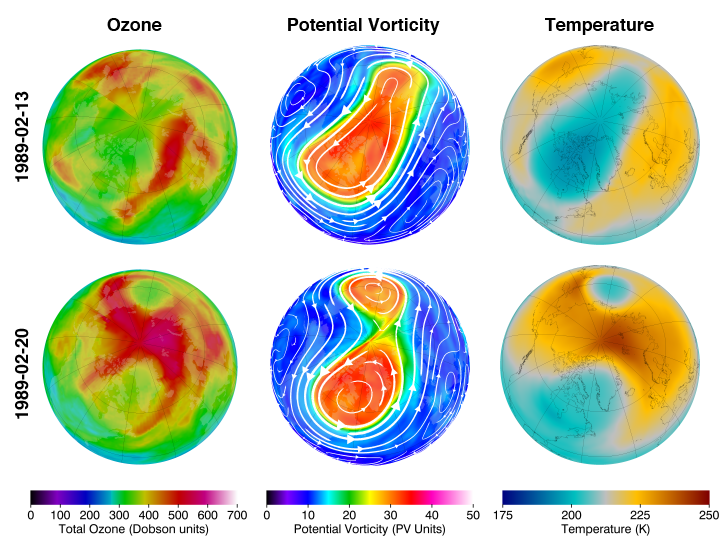- What is Ozone?
- What is a Dobson Unit?
- What are Ozone Mini-Holes?
- What is the Polar Vortex?
- What is a Stratospheric Warming?
Topics
What is a Polar Stratospheric Warming?
A stratospheric sudden warming is perhaps one of the most radical changes of weather that is observed on our planet. Within the space of a week, North Pole temperatures can increase by more than 50 K (90°F). For example, on 17 January 2009 the temperature at the North Pole near 30 km was about 200 K. Over a 5-day period, the temperature increased to 260 K (a change of 60 K or 108°F).
These stratospheric sudden warmings are caused by atmospheric waves that originate in the troposphere. The waves are forced by the large-scale mountain systems of the northern hemisphere and the land-sea contrasts between the continents and oceans. The waves are also characterized by their very large scales, typically referred to as planetary-scale waves. The stratospheric wind structure filters the smaller scale waves, only allowing the planetary waves to propagate into the stratosphere. As the waves move upward into the stratosphere they have two effects: first they will often push the polar vortex away from the North Pole—bringing warmer midlatitude air poleward, and second, they produce a downward motion field that also warms the polar region.

Northern hemisphere total ozone, potential vorticity on the 460 K potential temperature surface, and temperature on the 50 hPa pressure surface for 13 and 20 February 1989. This day is an example of a sudden stratospheric warming.
An example of a stratospheric warming is shown above. The top row of images are for 13 February 1989. The PV image indicates an elongated polar vortex (top middle image), while polar temperatures are relatively cold (top right) and total ozone is relatively low (top left). A week later on 20 February 1989, the polar vortex has split into two separate parts (bottom middle). This is known as a wave-2 pattern, since there are two high and two low centers. Note that the temperature (bottom right) and total column ozone (bottom left) have considerably increased at the pole. Other events are associated with a wave-1 pattern, where the vortex is displaced off the pole. This results in one side of the hemisphere having a relative high, while the other side has a relative low.
The most dramatic stratospheric sudden warmings are known as major warmings. During a major warming, at about 30 km the normal cold polar and warm midlatitude gradient is reversed and the west-to-east polar night jet reverses to an east-to-west flow. Sudden warmings are always characterized by large-scale, large-amplitude wave events. While major warmings only occur every other winter or so, wave events of weaker amplitude occur frequently during the winter season. All of these wave events act to warm and increase ozone levels in the polar region generally in proportion to their amplitude. The waves also act to strip off streamers of the polar vortex (similar to the cutting of a lathe). The waves cumulatively act to keep the polar region much warmer and ozone much higher during the winter than would occur in their absence.
The final warming is the last stratospheric warming of the season. After this warming, the stratosphere never recovers to its previous state and the vortex breaks up and dissipates. The final warming often occurs in March or April. Sometimes the stratosphere never recovers from what would otherwise be a mid-winter major warming in January or February, and that warming becomes the final warming.

